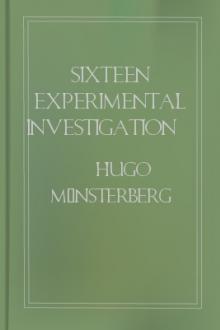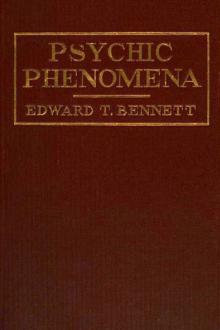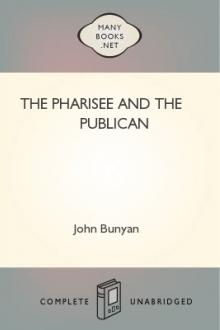The Beautiful, Vernon Lee [good ebook reader TXT] 📗

- Author: Vernon Lee
- Performer: -
Book online «The Beautiful, Vernon Lee [good ebook reader TXT] 📗». Author Vernon Lee
Such different thinkings away from the shapes are often traceable to previous orientation of the thoughts or to special states of body and feelings. But explicable or not in the particular case, these varieties of one's own aesthetic responsiveness will persuade the Reader who has verified their existence, that contemplative satisfaction in shapes and its specific emotion cannot be given by the greatest artist or the finest tradition, unless the beholder meets their efforts more than half way.
The spontaneous collaboration of the beholder is especially indispensable for Aesthetic Empathy. As we have seen, empathic modes of movement and energy and intention are attributed to shapes and to shape elements, in consequence of the modes of movement and energy involved in mere shape perception; but shape perception does not necessarily call forth empathic imagination. And the larger or smaller dynamic dramas of effort, resistance, reconciliation, cooperation which constitute the most poignant interest of a pictorial or plastic composition, are inhibited by bodily or mental states of a contrary character. We cease to feel (although we may continue, like Coleridge, to see) that the lines of a mountain or a statue are rising, if we ourselves happen to feel as if our feet were of lead and our joints turning to water. The coordinated interplay of empathic movement which makes certain mediaeval floor patterns, and also Leonardo's compositions, into whirling harmonies as of a planetary system, cannot take place in our imagination on days of restlessness and lack of concentration. Nay it may happen that arrangements of lines which would flutter and flurry us on days of quiet appreciativeness, will become in every sense "sympathetic" on days when we ourselves feel fluttered and flurried. But lack of responsiveness may be due to other causes. As there are combinations of lines which take longer to perceive because their elements or their coordinating principles are unfamiliar, so, and even more so, are there empathic schemes (or dramas) which baffle dynamic imagination when accustomed to something else and when it therefore meets the new demand with an unsuitable empathic response. Empathy is, even more than mere perception, a question of our activities and therefore of our habits; and the aesthetic sensitiveness of a time and country (say the Florentine fourteenth century) with a habit of round arch and horizontals like that of Pisan architecture, could never take with enthusiasm to the pointed ogeeval ellipse, the oblique directions and unstable equilibrium, the drama of touch and go strain and resistance, of French Gothic; whence a constant readmission of the round arched shapes into the imported style, and a speedy return to the familiar empathic schemes in the architecture of the early Renaissance. On the other hand the persistence of Gothic detail in Northern architecture of the sixteenth and occasionally the seventeenth century, shows how insipid the round arch and straight entablature must have felt to people accustomed to the empathy of Gothic shapes. Nothing is so routinist as imagination and emotion; and empathy, which partakes of both, is therefore more dependent on familiarity than is the perception by which it is started: Spohr, and the other professional contemporaries of Beethoven, probably heard and technically understood all the peculiarities of his last quartets; but they liked them none the better.
On the other hand continued repetition notoriously begets indifference. We cease to look at a shape which we "know by heart" and we cease to interpret in terms of our own activities and intentions when curiosity and expectation no longer let loose our dynamic imagination. Hence while utter unfamiliarity baffles aesthetic responsiveness, excessive familiarity prevents its starting at all. Indeed both perceptive clearness and empathic intensity reach their climax in the case of shapes which afford the excitement of tracking familiarity in novelty, the stimulation of acute comparison, the emotional ups and downs of expectation and partial recognition, or of recognition when unexpected, the latter having, as we know when we notice that a stranger has the trick of speech or gesture of an acquaintance, a very penetrating emotional warmth. Such discovery of the novel in the familiar, and of the familiar in the new, will he frequent in proportion to the definiteness and complexity of the shapes, and in proportion also to the sensitiveness and steadiness of the beholder's attention; while on the contrary "obvious" qualities of shape and superficial attention both tend to exhaust interest and demand change. This exhaustion of interest and consequent demand for change unites with the changing non-aesthetic aims imposed on art, together producing innovation. And the more superficial the aesthetic attention given by the beholders, the quicker will style succeed style, and shapes and shape-schemes be done to death by exaggeration or left in the lurch before their maturity; a state of affairs especially noticeable in our own day.
The above is a series of illustrations of the fact that aesthetic pleasure depends as much on the activities of the beholder as on those of the artist. Unfamiliarity or over-familiarity explain a large part of the aesthetic non-responsiveness summed up in the saying that there is no disputing of tastes. And even within the circle of habitual responsiveness to some particular style, or master, there are, as we have just seen, days and hours when an individual beholder's perception and empathic imagination do not act in such manner as to afford the usual pleasure. But these occasional, even frequent, lapses must not diminish our belief either in the power of art or in the deeply organised and inevitable nature of aesthetic preference as a whole. What the knowledge of such fluctuations ought to bring home is that beauty of shape is most spontaneously and completely appreciated when the attention, instead of being called upon, as in galleries and concerts, for the mere purpose of aesthetic enjoyment, is on the contrary, directed to the artistic or "natural" beauty of shapes, in consequence of some other already existing interest. No one except an art-critic sees a new picture or statue without first asking "What does it represent?"; shape-perception and aesthetic empathy arising incidentally in the examination which this question leads to. The truth is that even the art-critic is oftenest brought into enforced contemplation of the artistic shape by some other question which arises from his particular bias: By whom? of what precise date? Even such technical questions as "where and when restored or repainted?" will elicit the necessary output of attention. It is possible and legitimate to be interested in a work of art for a dozen reasons besides aesthetic appreciation; each of these interests has its own sentimental, scientific, dramatic or even moneymaking emotion; and there is no loss for art, but rather a gain, if we fall back upon one of them when the specific aesthetic response is slow or not forthcoming. Art has other aims besides aesthetic satisfaction; and aesthetic satisfaction will not come any the quicker for turning our backs upon these non-aesthetic aims. The very worst attitude towards art is that of the holiday-maker who comes into its presence with no ulterior interest or business, and nothing but the hope of an aesthetic emotion which is most often denied him. Indeed such seeking of aesthetic pleasure for its own sake would lead to even more of the blank despondency characteristic of so many gallery goers, were it not for another peculiarity of aesthetic responsiveness, which is responsible for very puzzling effects. This saving grace of the tourist, and (as we shall see) this pitfall of the art-expert, is what I propose to call the Transferability of Aesthetic Emotion.
CHAPTER XIX
THE STORAGE AND TRANSFER OF EMOTION
IN dealing with familiarity as a multiplying factor of aesthetic appreciation, I have laid stress on its effect in facilitating the perception and the empathic interpretation of shapes. But repetition directly affects the emotion which may result from these processes; and when any emotion has become habitual, it tends to be stored in what we call memory, and to be called forth not merely by the processes in which it originated, but also independently of the whole of them, or in answer to some common





Comments (0)